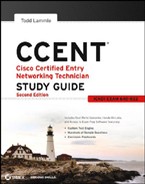Answers to Assessment Test
- A, C, E. To define a Class A address, the first bit in the first byte must be a zero. The range is 1 to 126, and the first octet represents the entire network portion of the address. See Chapter 2 for more information.
- C. The command line console 0 places you at a prompt where you can then set your console user-mode password. See Chapter 4 for more information.
- A. 256 − 192 = 64. 64 + 64 = 128. 128 + 64 = 192. The subnet is 128, the broadcast address is 191, and the valid host range is the numbers in between, or 129–190. See Chapter 3 for more information.
- B. The passive command, short for passive-interface, stops regular updates from being sent out of an interface. However, the interface can still receive updates. See Chapter 6 for more information.
- C. Internet Control Message Protocol (ICMP) is the protocol at the Network layer that is used to send echo requests and replies. See Chapter 2 for more information.
- D. Layer 2 switching creates individual collision domains. See Chapter 7 for more information.
- C. The command line vty 0 4 places you in a prompt that will allow you to set or change your Telnet password. See Chapter 4 for more information.
- A. The command erase-startup-config deletes the configuration stored in NVRAM. See Chapter 4 for more information.
- C. ICMP is the protocol at the Network layer that is used to send messages back to an originating router. See Chapter 2 for more information.
- A. Class A addressing provides 24 bits for hosts addressing. See Chapter 3 for more information.
- C. First, a /22 mask is 255.255.252.0, meaning you have a block size of four in the third octet. The subnet is 172.16.156.0. See Chapter 3 for more information.
- A. By default, switches break up collision domains but are one large broadcast domain. See Chapter 1 for more information.
- C. Segmentation happens at the Transport layer. See Chapter 1 for more information.
- D. Stub networks have only one connection to an internetwork. Only default routes can be set on a stub network or network loops may occur. See Chapter 6 for more information.
- B. A hub is a Physical layer device. See Chapter 1 for more information.
- B. The command show controllers s 0 tells you what type of serial connection you have. If it is a DCE, you need to provide the clock rate. See Chapter 4 for more information.
- C. The primary reason the OSI model was created was so that different networks could interoperate. See Chapter 1 for more information.
- C. The Transport layer creates virtual circuits between hosts before transmitting any data. See Chapter 1 for more information.
- C. User Datagram Protocol is a connection network service at the Transport layer, and DHCP uses this connectionless service. See Chapter 2 for more information.
- D. The command used to copy a configuration from a router to a TFTP host is copy flash tftp. See Chapter 8 for more information.
- E. The clock rate command is two words, and the speed of the line is in bits per second (bps). See Chapter 5 for more information.
- C. The command line vty 0 4 places you in a prompt that will allow you to set or change your Telnet password. See Chapter 4 for more information.
- B. The command enable secret todd sets the enable secret password to todd. See Chapter 4 for more information.
- C, E. WPA uses PSK to include authentication and can use either static or dynamic encryption keys. The benefit of WPA over a static WEP key is that WPA can change dynamically while the system is used. See Chapter 8 for more information.
- B. If a device knows the IP address of where it wants to send a packet but doesn't know the hardware address, it will send an ARP broadcast looking for the hardware address or, in this case, the Ethernet address. See Chapter 2 for more information.
- C. To enable RIP routing on a Cisco router, use the global config command router rip. See Chapter 6 for more information.
- D. If an AP does have SSID broadcasting disabled, the client needs to set the SSID value of the AP on the client software in order to connect to the AP. See Chapter 8 for more information.
- A. WPA2 uses the Advanced Encryption Standard (AES) known as the Counter Mode Cipher Block Chaining-Message Authentication Code (CBC-MAC) protocol (CCMP). See Chapter 8 for more information.
- B, D. Intrusion detection systems (IDSs) and intrusion prevention systems (IPSs). These tools help prevent threats by watching for trends, particular patterns, and other factors. See Chapter 9 for more information.
- B, C. You should always have a firewall on your network to block access from outside devices. In addition, Cisco recommends always using Secure Shell (SSH) instead of Telnet to configure your devices in-band. See Chapter 9 for more information.
..................Content has been hidden....................
You can't read the all page of ebook, please click here login for view all page.
